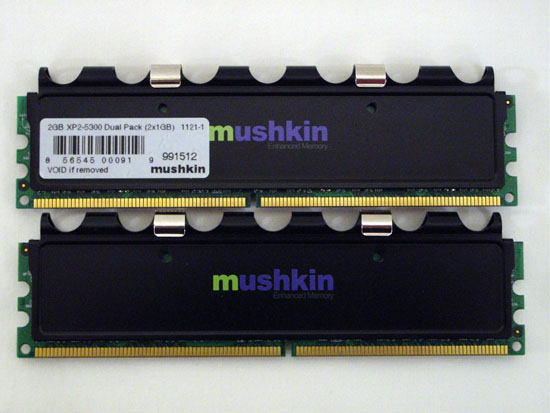Mushkin XP2 PC2-5300 DDR2 – Xtreme Performance Memory
by Steve Carmel & Wesley Fink on March 28, 2006 12:01 AM EST- Posted in
- Memory
A Closer Look
Mushkin ships this product in a simple, plastic clamshell package, which you can see in the image below.
Should you ever have any type of warranty or RMA claim, you will need the product information card, as Mushkin requires all the original packaging for returns.
Zooming in on the label shows how little information is provided to consumers by Mushkin on this product.
Mushkin ships this product in a simple, plastic clamshell package, which you can see in the image below.

Should you ever have any type of warranty or RMA claim, you will need the product information card, as Mushkin requires all the original packaging for returns.

Zooming in on the label shows how little information is provided to consumers by Mushkin on this product.















11 Comments
View All Comments
PrinceGaz - Tuesday, March 28, 2006 - link
"I know that the built in spreaders are fantastic for heat dissapation"There is a lot of debate over whether heatspreaders made any difference at all even with the hotter running DDR modules at 2.5V+. Many people believe the heatspreaders are more to do with making them look good rather than perform better. I really don't know either way as all the heatspreaders on my DDR modules seem to do is give a larger flat surface area for the heat to be dissipated from after the heat has been conducted from the individual chips (the heatspreaders even with overvolted modules don't feel particularly warm), and I'm unconvinced if
(a) there is any significant surface area in contact between the chips and heatspreader, let alone whether any thermal compound was used
(b) that might mean you would get better heat dissipation *without* a heatspreader as the cool air would be blowing directly over the memory chips themselves instead of having a heatspreader in the way
Given that DDR modules at normal voltages (up to 3V anyway, I'm not talking about the OCZ modules that could take 3.5V or so -- more than old SDRAM even) without getting very warm, why would cooler running DDR2 need heatspreaders unless pushed up from 1.8V to at least 2.3V. Memory chips don't give off much heat even when over-volted so heat-spreaders seem unnecessary, especially on DDR2 modules. Once you combine that with the fact that at least half the surface area of a memory module without a heatspreader is taken up by the memory chips anyway, there doesn't really seem much point in adding something to "spread" the heat over what is only a slightly larger area.
I will concede that heatspreaders look good though, and the minimal cost of them is returned many times in every premium module they sell with them.